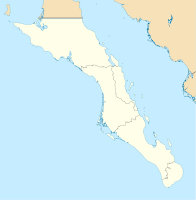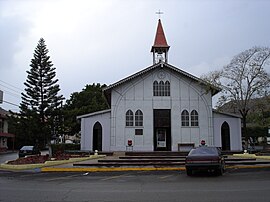Santa Rosalía
| Santa Rosalía | ||
|---|---|---|
|
Coordinates: 27 ° 20 ′ N , 112 ° 16 ′ W Santa Rosalía on the map of Baja California Sur
|
||
| Basic data | ||
| Country | Mexico | |
| State | Baja California Sur | |
| Municipio | Mulegé | |
| City foundation | 1868 | |
| Residents | 11,765 (2010) | |
| Detailed data | ||
| height | 10 m | |
| Post Code | 23920 | |
| prefix | 615 | |
| Santa Bárbara Church in Santa Rosalía | ||
Santa Rosalía , with a population of around 12,000, is an old mining town and the administrative seat of the Municipio Mulegé in the state of Baja California Sur in Mexico .
history
The city owes its existence and foundation to the rich copper deposits discovered in the region in 1868 . The processing plants and the shipping port were built by the French Compagnie du Boleo and commissioned in 1885. The company brought u. a. Indian workers from the Mexican state of Sonora to Santa Rosalia, which today Oaxaca [ wɑhɑkɑs call].
The Compagnie du Boleo worked until 1954, when its tax-free 70-year license expired and the operation was therefore no longer cost-covering. The company went bankrupt and the mine was closed. To support the city's economy, the Mexican government took over the facilities and operated them under the name CMSRSA (Compañía Minera Santa Rosalía SA) until 1985. Then the permanently loss-making operation was finally stopped. The factories slowly fell into disrepair, but still determine the image of the city today: the chimney and the spoil heaps above the city, the smelter and the old loading tower at the port. Some of the items were turned into exhibits, such as B. the locomotive at the entrance to the old town or various machines on the Mesa francésca.
Canadian investors acquired a new concession in 1992 and, for the next 15 years, drill holes and tests showed that there were still vast amounts of copper ore and significant deposits of cobalt , zinc and manganese on site. In 2010 the concessionaire, Minera y Metallurgica del Boleo (“MMB”), a subsidiary of Baja Mining Corp. from Vancouver , with the construction of the necessary hydrometallurgical facilities, but cost increases forced Baja Mining in 2012 to add a Korean consortium as the leading majority shareholder. The consortium is dominated by the state-owned Korea Resources Corporation (“KORES”) and since 2013 has owned 90% of MMB. Production is scheduled to start in 2015.
Most of the city's residents now make their living from deep-sea fishing and fish-processing companies.
German tall ship in the First World War
At the outbreak of World War I in August 1914, twelve German were tall ships in Santa Rosalia, the coke for the copper smelter of Compagnie du Boléo had delivered and / or wanted to invite copper ore. They were interned there by the Mexican government and stayed there until 1921 as trailers . These included the Adolf Vinnen , the Helwig Vinnen , the Walküre , the Egon , the Hans , the Orotava , the Reinbek , the Lasbek , the Schürbek , the Thielbek and the Wandsbek . At the end of the war, the ships were in very poor condition due to years of neglected maintenance. Since the German Reich had to surrender most of its merchant fleet after the Versailles Treaty , they were finally confiscated as spoils of war, in 1921 for a total of only 350,000 US dollars to the US wood and paper company Robert Dollar & Co. from San Francisco or its subsidiary Dollar Steamship Co. sold.
Worth seeing
- Santa Rosalía's old town is laid out in a checkerboard shape with buildings that are unique in Baja California. The houses and shops from the end of the 19th century are made of wood and built extremely close together. They stand wall to wall and there are no gaps between them, which is why fire protection in Santa Rosalía is of great importance.
- The most famous building in the city is the almost entirely steel church of Santa Barbara on Avenida Obregón. It was designed in 1884 by Gustave Eiffel , the builder of the Eiffel Tower in Paris, as a prototype for mission churches in French colonies, built in 1887 and exhibited and awarded a prize at the 1889 World Exhibition in Paris . It was originally supposed to be brought to Africa, but was discovered in 1894 - dismantled into its individual parts - by Charles Laforgue, director of the Compagnie du Boleo, in a warehouse in Belgium . He bought it, had it shipped around Cape Horn to Santa Rosalía and erected there in 1897.
- The technical buildings from the time of copper mining , the steel framework that once housed the processing halls and machines can still be viewed. The municipality of Santa Rosalía strives to preserve this industrial monument .
- The Biblioteca Mahatma Gandhi has a large selection of documentation on the Copper Age .
- The former French (now Mexican) bakery Panaderia el Boleo .
traffic
The port built by El Boleo is now the ferry port from this region to the mainland to Guaymas in the state of Sonora with daily connections. South of Santa Rosalía, halfway to Mulegé , there is a small airport with daily flights to Guaymas. The flight takes about 20 minutes and the ferry takes about 8 hours.
Web links
Individual evidence
- ^ Mineral Atlas - Santa Rosalía (El Boleó), Minerals
- ↑ The consortium also includes LS-Nikko Copper, Hyundai Hysco, SK Networks and Iljin Materials.
- ↑ fr: Compagnie du Boléo
- ↑ http://www.baja-web.com/sta-rosalia/st-rosal.htm
- ↑ Photo #: NH 50725 ( Memento from September 27, 2012 in the Internet Archive ) and Photo #: NH 50726 ( Memento from September 27, 2012 in the Internet Archive ) - Photos of the interned tall ships , taken from the gunboat USS Vicksburg .
- ↑ Archived copy ( memento of the original from January 20, 2012 in the Internet Archive ) Info: The archive link was inserted automatically and has not yet been checked. Please check the original and archive link according to the instructions and then remove this notice.

